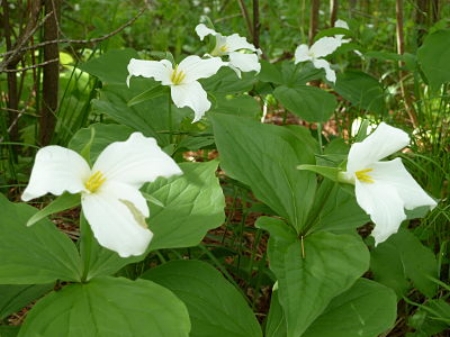The fleeting beauties of spring
/Lady's slipper anyjazz65/Flickr
Spring has been a late arrival this year with April snow storms and persistent chill. Things are just cranking up now and there’s still time to seek out spring ephemerals, a class of woodland plants that come and go between snow melt and the full leafing out of the tree canopy.
Half-hidden in the leaf duff, pink-veined spring beauties and lilac-blue hepatica may be lurking. On the damp stream banks and in the water itself, trout lilies, swamp cabbage and marsh marigolds spring into early bloom. If you know where to hunt, trilliums (also known as wake-robin) and lady slippers (a terrestrial orchid) are the potential reward for taking a hike in the month ahead.
“The spring ephemerals are such a joy to see, a promise that spring is coming,” says Randi Eckel, owner of the Toadshade Wildflower Farm in Frenchtown. “Many like trout lily and Virginia bluebells flower and then melt away as if they never were there at all. Some don’t completely disappear but become so inconspicuous that you’d never notice them among the new foliage of the forest floor.”
These delicate native wildflowers actually have a serious mission: They are crucial to the ants, flies, bees and other pollinators that are among the first to stir after a long, cold winter. Many of the flowers are downward-facing expressly to attract the notice of the small creatures that depend on them.
If you go “botanizing” in search of these little wild things (and we give some pointers below), remember to look but don’t touch. Poaching is not only wrong but usually futile. Many have extremely specific habitat requirements or depend on highly specialized soil organisms – or have root systems that can reach five feet in diameter. Most have seeds that are slow to germinate and can take years to reach a mature, blooming size.
“Picking is bad and poaching is worse,” says Eckel. “People are losing the common memory of our native wildflowers, so we want people to appreciate them. But in trying to dig them up you’re doing more harm than you know to a whole series of natural dependencies and relationships.”
If you’re determined to have some ephemerals of your own, many can be ordered from sources vetted by the Native Plant Society of New Jersey. It’s important to match plant and site – most prefer a slightly acid soil in the dappled shade of deciduous trees, but some won’t thrive in captivity no matter what you do.
Society member Stan Pukash grows nearly 200 species of native plants in his “Trillium Woods” in Chester, including some 20 species of its namesake flower. He opens his garden to tours by master gardeners and other groups, sharing the fruits of more than 20 years’ labor to establish a flowering woodland in its glory every spring.
“You don’t need an area as big as my acre, but don’t even think of doing this unless you first exclude the deer,” Pukash says. “Be prepared to do some serious weeding, too, since invasive plants like Japanese stilt grass and garlic mustard will try to take over.”
With those caveats, he recommends trilliums, Eastern columbines, hepatica and spring beauties as some of the easier ephemerals for beginners. Patience is a necessary virtue since, as mentioned, these plants can take their sweet time to establish themselves.
“I buy most of my plants online and do most of my planting in the spring,” Pukash notes. “I try to collect rainwater for them but aside from when they are just getting started, rarely fertilize. These are native plants – in the right place, they shouldn’t need coddling.”
While some bloom very early, late April and May are prime time for the spring ephemerals and every day Pukash is prepared to find some new treasure flowering in his woodland garden.
“Is it an obsession? I guess you’d say that,” he laughs. “In season I’m out there dawn to dusk. These flowers come and go pretty quickly. You have to be there or you’ll miss them.”
Trilliums k. steudel/Flickr
PLACES TO SEE SPRING EPHEMERALS
In New Jersey:
Above Buttermilk Falls in the Delaware Water Gap National Recreation Area. Trailhead is off Mountain Road in Layton, NJ. Park office, 1978 River Road, Bushkill, Pa. Call 570-426-2452.
Cheesequake State Park, 300 Gordon Road, Matawan. Call 732-566-2161. Good spot for lady’s slippers.
Emile K. Hammond Wildflower Trail in the Tourne County Park, McCaffrey Lane in Boonton Township. Maintained by the Rockaway Valley Garden Club.
Hacklebarney State Park, 119 Hacklebarney Road, between Long Valley and Chester. Call 908-638-8572.
Leonard J. Buck Garden, 11 Layton Road, Far Hills. Call 908-722-1200 Ext. 5011. See the website for what’s in bloom.
Musconetcong Gorge Preserve, 182 Dennis Road, Bloomsbury. Call 908-782-1158.
Farther afield:
Bowman’s Hill Wildflower Preserve, 1635 River Road, New Hope, Penna. Call 215-862-2924 or visit bhwp.org.
Mount Cuba Center, 3120 Barley Mill Road, Hockessin, Delaware. Call 302-239-4244 or see mtcubacenter.org. Open April to November.
LEARN MORE
A rich resource is the Native Plant Society of New Jersey, which has chapters throughout the state. See the website for a calendar of meetings and events, a gallery of wildflower photos and a list a native plant sources.
Pick up a wildflower field guide. Recommended are: “A Field Guide to Wildflowers of Northeastern and North-central North America,” Roger Tory Peterson and Margaret McKenny (Houghton Milfflin Co., 1968) and “Newcomb's Wildflower Guide,” Lawrence Newcomb (Little, Brown and Co., 1977).


